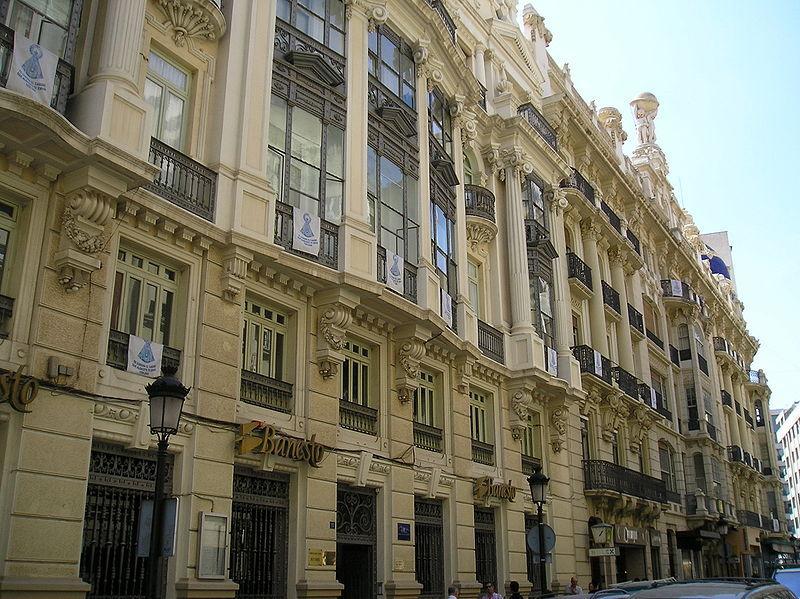Albacete, Castilla-La Mancha, Spain
Suggest Place to Visit
3832
Track to location with GPS |
 |
It is known from some ceramic finds that the origin of Albacete is in the Andalusian period, having been born as a small farmhouse near Chinchilla de Monte-Aragón, a square on which it depended for almost the entire Middle Ages. Its original name was Al-Basit (the plain).
After the battle of Las Navas de Tolosa, in 1212, the Christian kings broke the Almohad defenses and entered the depopulated and unprotected territories of La Mancha in Albacete. The small Al-Basit is taken in 1241, under the reign of Ferdinand III the Saint of Castile and handed over as a village to the powerful council of Alarcón.
Interior of the Pasaje de Gabriel Lodares, Albacete.
In the history of this province, and in general, in the history of the Spanish Middle Ages, the figure of Don Manuel, brother of King Alfonso X the Wise, has a great weight, who had achieved an important dominion after the conquest of the kingdoms Levantine Muslims.
The Lord of Villena began a huge repopulation effort, hoping to succeed where the king and the Order of Santiago had failed. Through the Villazgo Privilege, promulgated in the Garcimuñoz castle in 1375, Albacete is granted the title of independent town of Chinchilla. However, the lordship of Villena and later marquesed, would suffer numerous vicissitudes in the following years. For five years, the lands of Albacete were the scene of a warlike conflict between the supporters of the Catholic Monarchs and those of Juana la Beltraneja, supported by Don Diego López Pacheco, Second Marquis of Villena.
The end of the Marquis of Villena began in 1475, with the Alcaraz uprising.
Finally, the Catholic Monarchs and their supporters win the contest, and the Crown appropriates all the towns, expropriates the Marquis and the encomiendas of the Order of Santiago, and makes the weight of the new policy felt. The nobility, even the loser, is more than compensated and the cities see their privileges and privileges cut back.
The historical events that convulsed the Kingdom in the following centuries, affect Albacete in different ways. During the War of the Communities of Castile and except for a brief period, the capital, like the other great towns, remained faithful to the monarchy.
During the 18th century, Albacete was structured based on three nuclei: Alto de la Villa, El Cerrico and la Cuesta, with a barrier to the north on the Madrid-Valencia Highway. The three nuclei had a population of about 8,000 inhabitants. In September 1710, Felipe V granted the city the privilege of a frank fair. The city agrees to build a permanent building in the area of Santa Catalina, in the ´´eras´´ or ´´ejidos´´ of its property near the Acequión mill, to the west of the town.
During the Spanish War of Independence (1808-1812), the authorities sought refuge in the Sierra Albacete, from where they coordinated the resistance to the French army.
In 1833 the current province of Albacete was configured, with some variations, and this town as its capital. However, Albacete did not achieve the rank of city until 1862, by decree of Isabel II of Spain.
The confiscation of Mendizábal brought with it a great variation in the shape of the city, by taking advantage of various convents to configure squares such as Altozano.
During the Spanish Civil War, due to its proximity to the port of Cartagena and its strategic location as a communications hub, Albacete was the headquarters of the International Brigades. Like the rest of Spain, it suffered severely from the rigors of the Civil War, being bombed on various occasions. Even today you can see the traces of the Civil War, leaving the bomb shelters in the Plaza del Altozano as testimony to the past.
Albacete is a Spanish city located southeast of the Central Plateau, specifically in the historic region of La Mancha de Montearagón, although it is currently located within the region of Los Llanos de Albacete, of which it is its only municipality. It is the capital of the province of Albacete, belonging to the autonomous community of Castilla-La Mancha, and seat of the Superior Court of Justice of said autonomous community.
Albacete, with its 169,716 inhabitants (215,887 in the metropolitan area of attraction), according to data from the INE for 2009, is the largest city in number of inhabitants in all of Castilla-La Mancha.
The origins of the city are uncertain, although the first certainties of its existence are found during the Andalusian rule of the area, having been called the city originally as in 1575; e 1604; e 1576; e 1587; e 1610; e 1591; Al-Basit, in Arabic ´´El Llano´´, alluding to the flat character of the geography of the place.
Albacete Circuit
Carlos Belmonte Stadium
September Fair
Folkore Manchego
The tapas from April to August in Jardineillos
Comments
We don´t have yet any comments about:
Albacete
Albacete
Be the first to leave a comment as it is very important to inform other people
Outros locais a visitar
Within a radius of 20 km from:Albacete
Unfortunately we do not have information on other places to visit in this area yet
Hotel reservation near Albacete within a radius of 20 km
Why to book with FIND HOTEL ONLINE
The best prices
Our partnerships with the world´s largest operators offer research on the best market prices.
More options
At Rotas Turisticos you can book the hotel, buy the air ticket, book the transfer from the airport to the hotel and vice versa, book the local excursions, rent the car, take travel insurance and consult the places to visit and where to go.
Holiday Tips & Destinations
Hundreds of holiday destinations with all the options that allow you to easily choose the destination that best suits your dream vacation.
FIND HOTEL ONLINE
Links






